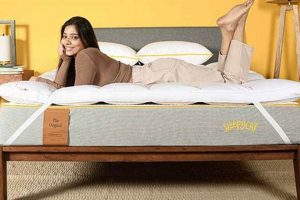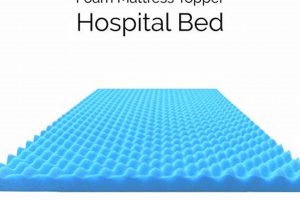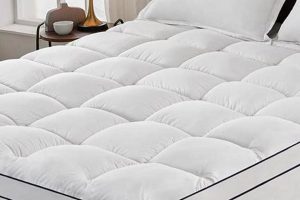An additional layer designed to increase the support provided by an existing sleeping surface represents a targeted solution for enhancing comfort. Commonly constructed from materials such as dense foam or latex, it addresses the issue of excessive sinkage often associated with yielding mattresses. For instance, individuals finding their current bed too plush can introduce this accessory to achieve a more stable and even plane.
The implementation of such an item can offer a multitude of advantages. It can promote proper spinal alignment, potentially alleviating back pain and discomfort. Furthermore, it provides a cost-effective alternative to replacing an entire mattress, extending the lifespan of the existing one. Historically, similar remedies have been utilized to modify sleeping surfaces, reflecting a continuous quest for personalized comfort and support.
The subsequent sections will delve into the specific types of materials employed in their construction, factors to consider when selecting one, and practical guidance on proper installation and maintenance. These considerations will enable a consumer to make an informed purchase decision.
Selection and Application Guidance
The following guidance provides salient points to consider when acquiring and utilizing an overlay intended to increase firmness.
Tip 1: Material Density Assessment: Evaluate the density of the constituent material. Higher density materials, such as high-density foam or latex, typically offer greater support and resistance to compression. A density exceeding 4 pounds per cubic foot is generally recommended for significant firmness enhancement.
Tip 2: Thickness Considerations: Select a thickness appropriate for the degree of firmness desired. A thinner overlay (2-3 inches) will provide a subtle increase in firmness, while a thicker option (4+ inches) will yield a more substantial alteration. Consider the user’s weight and preferred sleeping position when determining the optimal thickness.
Tip 3: Support Core Evaluation: Examine the support core, if present. Some overlays incorporate a core of springs or a convoluted foam design. A robust support core contributes to enhanced edge support and reduces the likelihood of sagging over time.
Tip 4: Cover Material Selection: Prioritize breathable cover materials, such as cotton or bamboo, to facilitate airflow and regulate temperature. Avoid synthetic covers that may trap heat and lead to discomfort.
Tip 5: Secure Attachment Method: Ensure the overlay incorporates a secure attachment method, such as elastic straps or a fitted sheet design, to prevent slippage and maintain proper alignment on the existing mattress.
Tip 6: Trial Period Utilization: Take advantage of any trial period offered by the vendor. This allows for a thorough assessment of the product’s suitability and comfort before committing to a final purchase.
Tip 7: Proper Installation and Maintenance: Follow the manufacturer’s instructions for proper installation and care. Regularly rotate or flip the overlay to promote even wear and extend its lifespan.
Adhering to these guidelines will facilitate a more informed decision and contribute to the effective utilization of a support-enhancing overlay.
The concluding section will summarize the key benefits and provide final recommendations for maximizing sleep comfort and spinal support.
1. Density
Density, measured in pounds per cubic foot (lb/ft), represents a critical determinant in the performance characteristics of a firm topper intended for a soft mattress. It dictates the material’s ability to resist compression and provide adequate support. A higher density indicates a greater mass of material packed into a given volume, translating to increased resistance to deformation under load. In the context of a sleeping surface, this directly influences the degree to which the topper counteracts the sinking effect of a yielding mattress. For example, a topper constructed from a high-density memory foam (5+ lb/ft) will offer significantly more support and maintain its shape better than a lower density alternative (3 lb/ft) when subjected to the weight of a sleeper. The practical significance of understanding density lies in its direct impact on spinal alignment and overall comfort; insufficient density can lead to inadequate support, negating the intended benefits of the product.
Furthermore, density influences the durability and longevity of the product. A low-density topper is more susceptible to compression set, a phenomenon where the material permanently loses its original height and firmness over time. This necessitates more frequent replacement, increasing the long-term cost to the consumer. Conversely, a higher density topper retains its structural integrity for a longer period, providing sustained support and value. Consider the example of latex toppers: natural latex, known for its inherent density and resilience, often outperforms lower-density synthetic alternatives in terms of both comfort and lifespan. Real-world applications of this principle are evident in hospital settings, where high-density mattresses and overlays are utilized to minimize pressure points and enhance patient comfort.
In conclusion, density serves as a key performance indicator for a firm topper designed to mitigate the effects of a soft mattress. Its impact extends from initial support and spinal alignment to long-term durability and cost-effectiveness. While other factors such as material composition and thickness contribute to the overall performance, density provides a foundational understanding of the product’s ability to effectively counteract excessive sinkage and maintain its structural integrity over time. Selection of a topper with appropriate density is therefore crucial to achieving the desired level of firmness and realizing the anticipated benefits.
2. Thickness
Thickness, in the context of a firm topper intended for a soft mattress, directly modulates the degree of firmness imparted to the sleeping surface. It represents a primary variable in tailoring support to individual needs. An appropriate thickness can mitigate excessive sinkage and promote improved spinal alignment.
- Impact on Support and Pressure Distribution
A thicker topper generally offers more substantial support and redistributes pressure more effectively. For instance, a 4-inch high-density foam topper provides a greater degree of resistance against compression compared to a 2-inch variant. This enhanced support can alleviate pressure points and improve comfort for individuals experiencing back pain or discomfort.
- Influence on Spinal Alignment
The thickness of the topper affects the alignment of the spine during sleep. An insufficient thickness may fail to provide adequate support, leading to spinal misalignment and potential
discomfort. Conversely, an excessively thick topper could elevate the sleeper too far above the underlying mattress, also disrupting spinal alignment. Selecting an appropriate thickness is, therefore, crucial for maintaining a neutral spinal posture. - Relationship with Body Weight and Sleeping Position
The optimal thickness of the topper varies based on body weight and preferred sleeping position. Individuals with higher body weights may require a thicker topper to achieve adequate support and prevent bottoming out. Similarly, side sleepers often benefit from a thicker topper to contour to the curves of their body and maintain spinal alignment, whereas back sleepers may find a thinner topper sufficient.
- Material Properties and Thickness Interaction
The interplay between material properties and thickness determines the overall firmness and feel of the topper. A thinner topper made of high-density latex can provide a similar level of support as a thicker topper made of lower-density memory foam. Understanding the characteristics of different materials is therefore essential when selecting a topper with the appropriate thickness.
In conclusion, the thickness of a firm topper functions as a pivotal factor in augmenting the support offered by a soft mattress. Its proper calibration is crucial for achieving optimal spinal alignment, pressure redistribution, and overall sleep comfort. The ideal thickness is contingent on individual factors such as body weight, sleeping position, and the specific material composition of the topper itself. A balanced consideration of these elements ensures the selection of a topper that effectively addresses the shortcomings of an excessively soft underlying mattress.
3. Material
The composition of a firm topper critically determines its capacity to augment the support provided by a soft mattress. Material selection directly influences firmness, durability, breathability, and pressure relief, all of which contribute to improved sleep quality. Understanding the properties of various materials is, therefore, essential for selecting an appropriate topper.
- High-Density Memory Foam
High-density memory foam conforms closely to the body, distributing weight evenly and reducing pressure points. Its visco-elastic properties allow it to slowly recover its shape after compression, providing customized support. For instance, a high-density memory foam topper can alleviate pressure on the hips and shoulders for side sleepers, promoting spinal alignment. However, memory foam can retain heat, potentially leading to discomfort for some individuals.
- Latex (Natural and Synthetic)
Latex offers a resilient and responsive alternative to memory foam. Natural latex, derived from rubber trees, is known for its durability and breathability. Synthetic latex provides a similar feel at a lower cost but may lack the same longevity. A latex topper offers consistent support across the sleeping surface and is less prone to heat retention than memory foam. Individuals seeking a more buoyant and supportive feel often prefer latex.
- Polyurethane Foam (Conventional and High-Resilience)
Polyurethane foam, commonly used in bedding, varies significantly in density and resilience. Conventional polyurethane foam is less durable and provides less support than high-density options. High-resilience (HR) polyurethane foam offers improved support and responsiveness. A high-resilience polyurethane foam topper can enhance firmness without the excessive sinkage associated with memory foam. However, the long-term durability may be lower compared to latex or high-density memory foam.
- Wool
Wool acts as a natural fiber that creates a firm sleeping surface and it is a very firm option for mattress toppers. It creates a support and a comfortable experience for those who has back pain. It is a great alternative for those who doesn’t like foam material, and create a more natural comfort. This option is rare but is recommended for a better sleep.
The selection of topper material represents a critical decision point in optimizing sleep comfort and spinal support. The chosen material must align with individual preferences, body weight, sleeping position, and any specific needs, such as pressure relief or temperature regulation. Ultimately, the correct material choice transforms a soft mattress into a supportive sleep surface.
4. Support
In the context of a firm topper designed for a soft mattress, “support” embodies the ability to resist deformation under load, maintaining a stable and level sleeping surface. A lack of adequate support from the original mattress often necessitates the addition of a firmer topper. The topper functions to counteract excessive sinkage, preventing spinal misalignment and pressure point concentration. The level of support offered by the topper is directly proportional to its density and material composition. For example, a high-density foam topper provides more substantial support than a low-density alternative, effectively preventing the sleeper from sinking too deeply into the mattress. This enhanced support translates to improved spinal alignment, reduced back pain, and a more restful sleep experience.
The importance of support extends beyond mere comfort; it directly impacts musculoskeletal health. An unsupported spine can lead to chronic pain and discomfort. The topper acts as a corrective measure, providing the necessary support to maintain a neutral spinal posture during sleep. Consider the scenario of an individual with a history of lower back pain using a soft mattress. The addition of a firm topper effectively addresses the lack of support, redistributing weight and alleviating pressure on the lower back. This practical application highlights the significant role support plays in improving overall well-being. Selection of a topper must account for individual weight, sleeping position, and specific support requirements to achieve optimal results.
In summary, support constitutes a critical element in the functionality of a firm topper designed for a soft mattress. It serves to counteract excessive sinkage, promote spinal alignment, and reduce pressure points. Understanding the relationship between support, material density, and individual needs enables informed decision-making, ultimately contributing to improved sleep quality and musculoskeletal health. Challenges may arise in accurately assessing individual support needs, requiring careful consideration of factors such as body weight and sleeping position. Addressing these challenges is crucial for maximizing the benefits of a firmness-enhancing overlay.
5. Durability
Durability represents a fundamental characteristic when evaluating the efficacy of a firm topper intended for use on a soft mattress. The longevity of the topper directly impacts its cost-effectiveness and long-term suitability for providing enhanced support.
- Material Degradation Resistance
The inherent resistance of the topper’s constituent material to degradation under repeated compression and use dictates its lifespan. Materials prone to compression set, suc
h as low-density polyurethane foam, exhibit diminished support over time, necessitating more frequent replacement. Conversely, materials like high-density latex or memory foam demonstrate greater resistance to degradation, maintaining their firmness and support characteristics for an extended period. Consider, for instance, a latex topper subjected to daily use; its inherent resilience allows it to retain its shape and support properties for several years, unlike a lower-quality foam option that may exhibit significant sagging within a year. - Construction Integrity
The method of construction and the quality of seams and bonding agents influence the structural integrity of the topper. Weak seams or poorly bonded layers can lead to premature failure, compromising the topper’s ability to provide consistent support. A well-constructed topper with reinforced seams and durable bonding agents will withstand the stresses of repeated use, extending its lifespan. Real-world examples include toppers with quilted covers and reinforced edges, which exhibit greater resistance to wear and tear compared to simpler designs.
- Resistance to Environmental Factors
Exposure to environmental factors, such as humidity and temperature fluctuations, can accelerate the degradation of certain topper materials. Humidity promotes the growth of mold and mildew, while temperature fluctuations can cause materials to expand and contract, leading to structural damage. Toppers constructed from moisture-resistant and temperature-stable materials demonstrate greater durability in diverse environmental conditions. Examples include toppers with breathable covers and antimicrobial treatments, which mitigate the effects of humidity and temperature fluctuations.
- Weight Capacity and Load Distribution
The topper’s ability to withstand the weight of the sleeper without compromising its structural integrity is a critical determinant of durability. Exceeding the weight capacity or uneven weight distribution can accelerate wear and tear, leading to premature sagging or deformation. Toppers designed with high-density materials and reinforced support structures exhibit greater resistance to weight-induced damage. Real-world applications include toppers specifically designed for heavier individuals, which incorporate thicker layers of high-density foam and reinforced edges to ensure long-term support and durability.
The durability of a firm topper represents a critical investment consideration. Selection of a topper constructed from durable materials and possessing robust construction ensures sustained support and long-term cost-effectiveness. Proper maintenance and care, including regular rotation and protection from environmental factors, further enhance the longevity of the topper. Ultimately, durability translates to a more reliable and sustainable solution for enhancing the firmness of a soft mattress.
6. Breathability
Breathability, in the context of a firm topper designed for a soft mattress, refers to the material’s capacity to facilitate air circulation and dissipate heat. This attribute is critical for maintaining a comfortable sleeping temperature and preventing the accumulation of moisture, which can negatively impact sleep quality and the longevity of the topper itself. The selection of materials with inherent breathability is paramount to mitigating heat retention, a common complaint associated with some types of mattress toppers, particularly those constructed from dense memory foam. A lack of adequate air circulation can lead to increased body temperature, resulting in discomfort and disrupted sleep patterns. This is particularly relevant for individuals who tend to sleep hot or reside in warmer climates. For example, a firm latex topper, known for its open-cell structure, inherently promotes greater airflow compared to a closed-cell memory foam alternative, thereby reducing the risk of overheating.
The importance of breathability extends beyond mere comfort, influencing the hygiene and durability of the sleeping surface. Proper air circulation helps to wick away moisture produced by perspiration, preventing the growth of mold, mildew, and bacteria within the topper. These microorganisms can contribute to unpleasant odors and allergic reactions, compromising the overall healthiness of the sleeping environment. Furthermore, excessive moisture can accelerate the degradation of certain materials, shortening the lifespan of the topper. Consider the practical application of a topper incorporating a breathable cover, such as one made from natural cotton or bamboo fibers. These materials allow for greater air exchange, minimizing moisture buildup and extending the functional life of the product. Real-world examples demonstrate that individuals using breathable toppers experience improved sleep quality and a reduced incidence of skin irritation or allergic reactions.
In summary, breathability represents a crucial attribute of a firm topper intended to enhance the support of a soft mattress. Its impact encompasses both comfort and hygiene, influencing sleep quality, material durability, and overall health. Challenges remain in accurately quantifying and comparing the breathability of different topper materials, necessitating careful consideration of material composition and construction techniques. Overcoming these challenges is essential for selecting a topper that effectively addresses the shortcomings of an overly yielding mattress while maintaining a comfortable and hygienic sleeping environment. The interplay of firm support and breathability is a key factor in achieving optimal sleep quality.
7. Cost
The cost associated with a firm topper for a soft mattress represents a significant factor in the decision-making process. This expense must be weighed against the alternative: replacement of the entire mattress. The initial investment in a topper is often substantially less than the cost of a new mattress, making it an economically attractive option for those seeking to enhance support without incurring a large capital outlay. The expenditure on the topper, however, is not the sole financial consideration. The lifespan of the topper, its material composition, and any associated maintenance all contribute to the overall cost of ownership. A less expensive topper constructed from lower-quality materials may require more frequent replacement, negating any initial savings. In contrast, a higher-priced, more durable topper could prove more cost-effective over the long term.
The cost of a firm topper is further influenced by material selection. Latex toppers, particularly those made from natural latex, tend to command a higher price due to the cost of raw materials and manufacturing processes. High-density memory foam toppers represent another relatively expensive option, while conventional polyurethane foam toppers offer a lower-cost alternative. The choice of material should align with both budgetary constraints and desired performance characteristics. For example, an individual experiencing back pain might prioritize the pressure-relieving properties of a more expensive memory foam topper, while someone seeking a general increase in firmness may opt for a less costly polyurethane foam alternative. Real-world examples abound, ranging from budget-conscious consumers selecting basic foam toppers to individuals investing in premium latex options to address specific health concerns.
In summary, the cost of a firm topper for a
soft mattress is a multifaceted consideration. It encompasses the initial purchase price, the expected lifespan of the topper, material composition, and potential maintenance expenses. A comprehensive cost-benefit analysis, factoring in individual needs and budgetary limitations, is essential for making an informed decision. While a lower initial price may seem appealing, long-term durability and performance characteristics should be carefully evaluated to ensure that the chosen topper provides a cost-effective solution for enhancing sleep comfort and spinal support. The challenges often lie in assessing the long-term value and performance of different materials, requiring research and consideration of user reviews. Ultimately, the cost of the topper must be justified by its ability to provide a substantial improvement in sleep quality and musculoskeletal health.
Frequently Asked Questions
The following represents a compilation of frequently encountered inquiries pertaining to the selection and utilization of a firmness-enhancing overlay.
Question 1: What constitutes the primary benefit of employing a firm topper on a soft mattress?
The primary benefit lies in augmenting the support provided by the existing mattress. A firm topper mitigates excessive sinkage, promoting proper spinal alignment and potentially alleviating back pain.
Question 2: How does material density influence the performance of a firm topper?
Material density directly correlates with the level of support offered. Higher density materials, such as high-density foam or latex, exhibit greater resistance to compression, resulting in a firmer sleeping surface.
Question 3: What thickness should be considered when selecting a firm topper?
Thickness depends on the desired degree of firmness and individual body weight. A thicker topper generally provides greater support, while a thinner option offers a subtle increase in firmness. Body weight should also be considered.
Question 4: Does the material composition of a firm topper affect breathability?
Yes, material composition significantly influences breathability. Materials like natural latex and open-cell foams promote greater airflow, preventing heat retention and moisture accumulation. Avoid fully synthetic material if breathability is a key concern.
Question 5: How can the durability of a firm topper be assessed?
Durability is determined by the inherent resistance of the material to degradation, the quality of construction, and resistance to environmental factors. Look for high-density materials, reinforced seams, and moisture-resistant covers.
Question 6: Is a firm topper a viable alternative to replacing an entire mattress?
In many instances, a firm topper offers a cost-effective alternative to replacing a mattress, particularly when the underlying mattress is otherwise in good condition. However, if the existing mattress exhibits significant sagging or structural damage, replacement may be the more appropriate solution.
These answers provide a foundation for understanding the key considerations when choosing a firm topper. Careful evaluation of individual needs and material properties is essential for making an informed decision.
The following sections will delve into specific product recommendations and comparative analyses of different topper options.
Firm Topper for Soft Mattress
The preceding analysis has explored the multifaceted considerations involved in utilizing a firm topper for soft mattress. From material density and thickness to breathability and cost, each element contributes significantly to the topper’s overall effectiveness. A judicious selection process, informed by an understanding of these factors, is essential for achieving the desired enhancement in support and comfort.
The decision to employ a firm topper necessitates a comprehensive evaluation of individual needs and preferences. While offering a potentially cost-effective alternative to mattress replacement, the long-term benefits hinge on selecting a product that aligns with specific requirements. Continued research and innovation in material science will likely yield further advancements in topper technology, offering consumers increasingly sophisticated options for optimizing their sleep environments. Prudent consumers will remain informed and discerning in their pursuit of restorative sleep.







